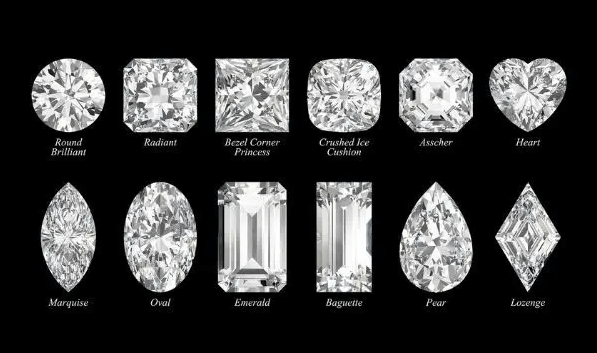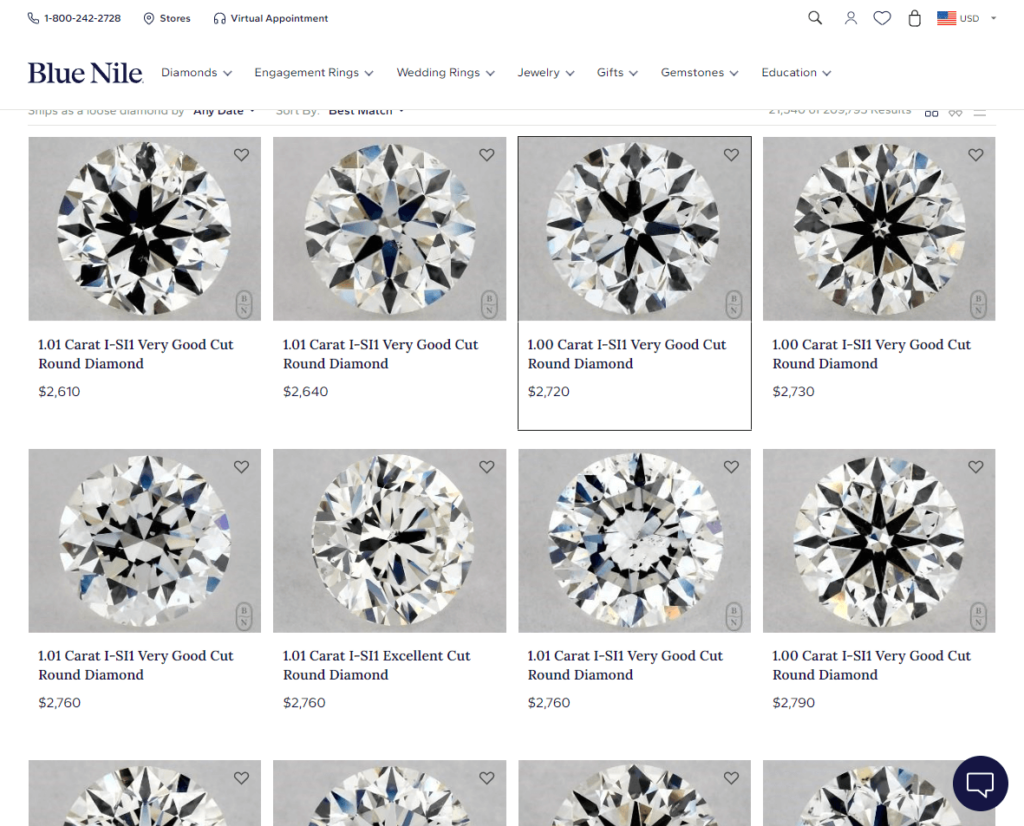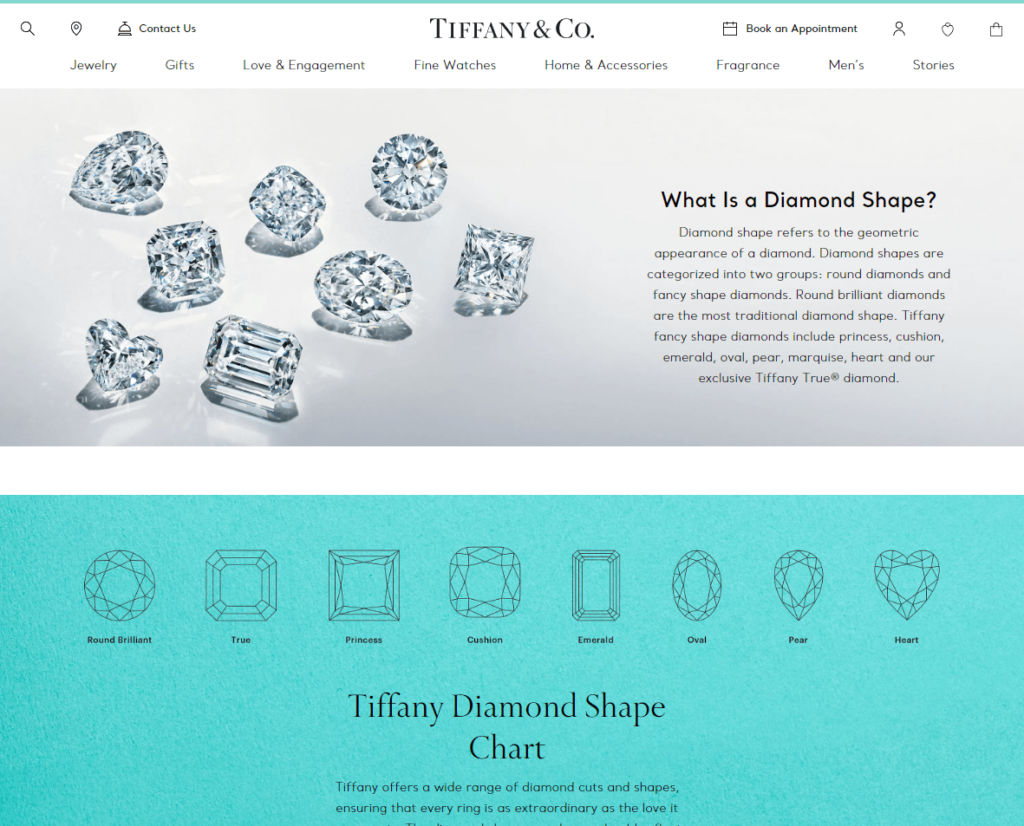Diamond Shape Guide: Attention diamond enthusiasts! Have you ever wondered how the sleek cut of a diamond not only turns heads but also turns the scales of its value? Dive into our Diamond Shape Guide to see how much shape affects your wallet.
Interest is sparked as we reveal why the beloved round diamond—renowned for its unrivaled brilliance—often demands a higher price. It’s not just about its eye-catching shimmer; it’s also about the diamond dust left behind during meticulous crafting.
Desire blooms as we explore each diamond shape, from the sophisticated oval to the bold marquise, each with its price tag and captivating backstory. BrighterGuide invites you to unveil these sparkling secrets.
With insider knowledge at your fingertips, you’re set to spot exceptional value and select a diamond that not only reflects your taste but also makes financial sense. Let’s embark on this shimmering journey together, where choosing wisely leads to a treasure as economical as it is exquisite.
Key Takeaways
- Diamond shape plays a significant role in determining the price of a diamond, with factors like demand, cutting techniques, and market popularity influencing prices.
- Round-cut diamonds are the most expensive due to their exceptional brilliance and versatility. Princess and cushion cuts, while popular, are generally less costly than round diamonds but still offer unique faceting patterns.
- Emerald and Asscher cuts, inspired by Blue Nile, with their subtlety and fewer facets, are typically more affordable than princess or round cuts, making them an attractive choice for those seeking elegance.
Why Some Diamond Shapes Are More Expensive Than Others

When it comes to the dazzling world of diamonds, not all shapes are created equal. The diamond industry, guided by diamond cutters, has given us a wide selection of shapes that each offer their own unique visual impact. Let’s dive into how demand, rarity, and manufacturing expenses influence the price of various diamond shapes.
Round-cut diamonds are perhaps the most popular shape and, consequently, the most expensive diamond shape. Thanks to their symmetrical, circular shape and brilliant sparkle, they have a timeless appeal. This is what we often see in a wide range of diamond jewelry, from diamond rings to diamond stud earrings. The cut grades for round-cut diamonds are usually high, making them a top-notch, albeit pricier, choice for engagement rings.
Then we have princess-cut and cushion-cut diamonds. These shapes have rounded corners and a square shape, bringing a contemporary touch to traditional style. The unique faceting patterns of these shapes cause them to emit bright flashes of light. These are relatively more affordable than round diamonds but no less stunning.
Fancy shapes like emeralds and Asscher diamonds offer elongated shapes with fewer facets and a vintage style. With their larger facets and clarity grades that focus more on clarity over brilliance, they’re less expensive than princess or round cuts. The subtlety and beauty of these shapes make them perfect for those who admire Art Deco designs and want a fair deal on their diamond purchase.
Diamond Prices by Shape
Diamond prices depend on market popularity and cut quality. Demand for various diamond shapes raises their price, while cut quality dictates brilliance and sparkle.
These parameters, together with carat weight and clarity, affect diamond prices across shapes.
While understanding how shape impacts a diamond’s price is crucial, don’t miss out on our curated list of the most affordable diamond shapes that blend quality with cost-efficiency
Popularity On The Market

Popular diamond shapes increase their price. Diamonds like round brilliant cut diamonds are more expensive due to their popularity and shine. These diamonds are conventional and premium due to their brilliance and adaptability.
However, cushion cuts and princess cuts are also popular, but they cost less than round diamonds. For unique and beautiful diamond shapes, cushion cuts and princess cuts are appealing due to their rectangular shape and brilliant faceting pattern.
The market price of a diamond shape depends on its popularity.
How Well Cut The Diamond Is
Diamond prices depend on how beautifully they are cut.
How nicely a diamond is fashioned and faceted affects its brightness and shine. Diamonds seem better when cut well because they reflect light.
The round diamond is the most expensive diamond cut. Perfectly cut round diamonds are prized for their light performance and symmetry. Princess, cushion, and radiant cuts can provide equivalent brightness at a lower cost.
When considering pricing, diamond grades and quality are crucial. A well-cut diamond will always cost more because of its greater craftsmanship and aesthetics.
What Are The Most Popular Diamond Shapes

Round, princess, cushion, and emerald-cut diamonds are the most popular. These forms are popular for diamond engagement rings and other jewelry. These shapes are popular due to their adaptability and timeless charm.
The most popular and valuable diamond shape is round. Classic diamond shapes have great sparkle and fire. Round diamonds sparkle because they reflect light. Round diamonds are more expensive than other forms due to their popularity.
The second-most popular diamond shape is a princess. They seem sleek and stylish and are square or rectangular. Princess-cut diamonds are cheaper than round diamonds, making them popular with budget-conscious buyers.
Cushion-shaped diamonds are vintage in style. Their bigger facets emit a gentle glow and add timeless charm. For a larger diamond look and a unique shape, cushion-cut diamonds are preferred.
Always fashionable: emerald diamonds. They’re rectangular with step-cut facets to display diamond clarity. Emerald cuts are cheaper than round and princess cuts, making them a popular choice for individuals who want a beautiful diamond look without the price.
What Is Diamond Shape vs. Diamond Cut
When assessing a diamond, its shape—its overall outline—and cut—how well it has been faceted to maximize its brilliance and sparkle—are important variables. Diamond form and cut affect pricing and value.
Some things to consider:
- Diamond shape: A diamond’s top outline. Round, princess, emerald, oval, pear, and marquise diamonds are popular. Each shape is unique and appealing.
- Diamond cut: How nicely a diamond is faceted maximizes its brightness and shine. Perfect angles and proportions let light reflect and refract within a well-cut diamond, maximizing sparkle.
- Price: Diamond shape and cut affect price. Due to their popularity and the amount of rough diamonds wasted during cutting, round brilliant diamonds are the most expensive. Princess, emerald, pear, marquise, and oval-cut diamonds are cheaper because they may be cut to maximize rough diamond utilization.
Understand the relationship between diamond shape and cut to make an informed diamond purchase. Consider price, carat weight, and personal preferences to pick the right diamond for your style and budget.
What’s the Most Expensive Diamond Cut
The most expensive diamond cut is round. Many consumers prefer round diamonds for their brilliance, adaptability, and popularity. Their superior light output and perceived flawlessness make them a premium alternative with incomparable sparkle and brilliance.
You can check the diamond buying guide to help you with your choices.
What’s the Cheapest Diamond Shape
A pear or marquise-cut diamond is usually the cheapest. These forms are cheaper than round, princess, and cushion cuts because they are less prevalent. However, carat weight, color, clarity, and cut quality can still affect pear and marquise cut diamond prices.
More on why the pear or marquise cut is the cheapest diamond shape:
- Less demand: Pear and marquise cuts cost less since they are less popular.
- Lower diamond waste: Cutting these shapes uses less diamond, lowering costs.
- For those on a budget: Pear and marquise cut diamonds give a unique shape at a lower price.
Conclusion
When you’re hunting for that perfect diamond, remember that its shape does more than just catch the eye—it also affects your wallet. Cutting a diamond to sparkling perfection often means losing some of it in the process, which can up the price, especially for the ever-popular round brilliant cut. Here’s a tip: other stylish shapes like those offered by Blue Nile, such as the Asscher, radiant, emerald, princess, and cushion cuts might be kinder to your budget.
Looking for value and beauty? Check out our handpicked collection of diamonds to find a cut that fits your style and price range. Each shape brings its own flair and requires a different level of craftsmanship; these details influence the final cost. It’s not all about shape; the clarity, color, and quality of the diamond are also crucial price factors.
When choosing the centerpiece for an engagement ring, balance what you love with what you’re willing to spend. From the precision of the cut to the current market trend, the shape of a diamond is just as important as the choice to propose. So take your time, do your homework, and pick a diamond that shines bright for both its style and its smart value.
Sources
BrighterGuide is dedicated to providing accurate and relevant information as you explore the wonderful world of diamonds and jewelry. To this end, our writers refer to primary information sources in building each article that appears on this website. These include, but are not limited to, published news articles, government portals, research papers, and more.
- International Gem Society LLC. (2022, October 19). International Gem Society IGS – Information and educational services for everyone interested in gemstones. International Gem Society. https://www.gemsociety.org/
- Goyal, R. (n.d.). Responsible sourcing in the colored gemstone business – International Colored Gemstone Association. https://www.gemstone.org/news/responsible-sourcing-in-the-coloured-gemstone-business
- Rabideau, C. (2023, June 27). The 11 most popular diamond shapes for engagement rings. Reviewed. https://reviewed.usatoday.com/weddings/features/11-most-popular-diamond-shapes-engagement-rings